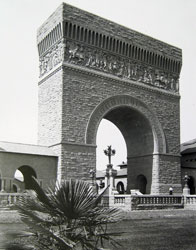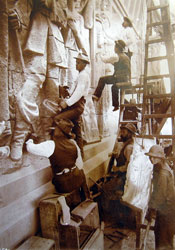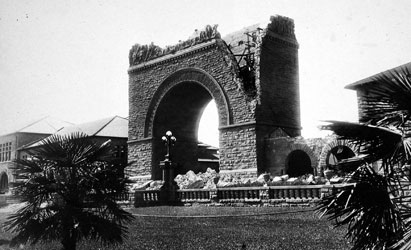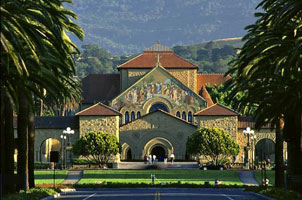|
|
||||||||||
 |
|
|
|
|||||||
|
|
||||||||||
|
|
|
|
|
|
|
|
|
|||
|
|
|
|
|
|
|
|
|
|
|
|
Walking Tour
| << Previous Stop |
 |
||||||||
|
Beyond property damage, loss of prestige is a serious issue that the University faces in the aftermath of an earthquake. Paired with alarming reports of destruction, images such as the broken Memorial Arch, Agassiz’ feet poking out of the concrete in front of the Quad, and the collapsed entry gates significantly altered Stanford’s national reputation for at least a decade after the 1906 earthquake. Memorial Arch Memorial Arch was planned concurrently with Memorial Church and erected at the entry to the Main Quadrangle in memory of Leland Stanford Junior. Most of the Arch was constructed in 1899, but it was not until three years later that its frieze, “The Progress of Civilization,” was completed (Figure 1). Among the many idealized panels in the frieze designed by John Evans (an assistant to Boston architect Charles Allerton Coolidge) was one that depicted Leland and Jane Stanford on horseback mapping a course over the Sierras for the Central Pacific Railroad. Like the Church, Memorial Arch was symbolic of the power and influence of the University’s founders and was designed to be a focal point of the Main Quadrangle. When the earthquake struck a few years later, Memorial Arch was a poignant image: it had lost its heavy stone cap, including its frieze; gaping seams extended down the sides of the Arch all the way to the bases; and falling fragments of the Arch had broken down the adjoining arcades and crushed a portion of the Assembly Hall in Building 120 (Figure 2). Richard Joncas et al. explain, “The gate’s massiveness […] was only superficial: built of unreinforced brick faced with stone, the arch was a hollow shell containing stairways at either end leading to an observation deck.” Because Memorial Arch was so massive and had been composed of unreinforced masonry, the work that it would take to repair and protect it from future damage was extensive and would require a complex new steel structural system. The Commission of Engineers estimated in 1906 that the cost would be $131,000 ($2.7 million in 2005), not including an additional $30,000 to replace the frieze. Faced with this information, the University decided that Memorial Arch would not be reconstructed. The top of the Arch extending above the arcades was dismantled and the bases capped with pyramidal red tile roofs. Today, the bases bearing the dedication plaque are all that remains of the original monument, but it is generally agreed that this alteration by natural occurrence actually improved the strength of the overall architectural ensemble of the Main Quadrangle (Figure 3).
Figure 3: View of the Quad from Palm Drive today, with Memorial Arch reduced to its bases. Image courtesy of Stanford News Service. Agassiz in the Concrete The Agassiz statue is the most famous of all images related to Stanford’s earthquake history (Figure 4). During the 1906 temblor, the stone shelf supporting a marble statue of Swiss naturalist and geologist Louis Agassiz on the second story of the north wall of the Zoology building (now Building 420) failed, causing the statue to plunge into the ground below. There are several accounts of the outcome. One student wrote, “A big marble statue of Agassiz was toppled off his perch on the outside of the quad and fell foremost into the ground (right through a cement walk) up to his shoulders, and still sticks there, legs in the air and his hand held out gracefully. People came running from the quad with such sober faces, but when they saw him they couldn’t help laughing, and one fellow went up and shook hands with him.” “Agassiz in the concrete” remained a legend associated with the earthquake period. According to one account, “Many stories were told about Agassiz’s natural instinct that when the earthquake came he decided to stick his head underground to find out what was going on in the earth below and with his finger pointing saying, ‘Hark! Listen!’ […] Out of the four statues only Agassiz evidently aroused his searching curiosity.” (The other statues honored Johann Gutenberg, Benjamin Franklin, and Alexander von Humboldt. Von Humboldt, Agassiz’s mentor, still stands next to him today, but the others were removed when the building became the Law School (Figure 5).) President David Starr Jordan wrote, “Somebody—Dr. Angell, perhaps—remarked that ‘Agassiz was great in the abstract but not in the concrete.’” What was most extraordinary about the incident was that the statue was imbedded into the ground below nearly to the hips but only broke at the nose. The nose was refastened and the statue was returned to its original place, this time better secured. As amusing as this image of Agassiz was to the Stanford community, it suggested to the public that Stanford was in chaos. Figure 5: Today, Louis Agassiz and Alexander von Humboldt's states are securely mounted above the entry to Jordan Hall. News Reports Incite Fear The 1906 San Francisco earthquake received international attention, which shed the spotlight on the young Stanford University whose high hopes had been dashed. The first article to describe Stanford’s condition in the New York Times on April 19th reported that “all but two of the fine buildings were demolished.” A less exaggerated but still alarming article printed on April 30th headlined “HOW STANFORD FELL IN HEAPS OF RUINS.” Paired with images of Memorial Arch, the Agassiz statue, and the flattened entry gates (Figure 6), such publications convinced those outside of Stanford that the University would likely never recover from the damage. The Alumni Association and other entities went about setting the record straight, and later reports, such as one on May 7th, improved the outlook. The Times explained: “President Jordan is sanguine of the future, as the university has a fi ne endowment and a very large income which permits engaging the best men in all departments. The buildings in future will be provided with steel frames and be built of concrete and will thus be earthquake proof.” The damage had been done, however, and Stanford disappeared almost entirely from the media for approximately 15 years. Applications decreased significantly and did not return to their previous levels until 1915. Professors’ salaries also had to be increased by 60 percent in order to retain faculty who might have otherwise transferred to institutions whose futures were more certain. Figure 6: Scrapbook page showing the collapse of the entry gates on Palm Drive. Arch’s Designer, Charles Hodges It was not just Stanford’s reputation that was marred in the aftermath of the 1906 disaster. The quake was also credited with causing resident architect Charles Hodges to resign: “[I]t is believed that his resignation is due to the criticisms that have been made as a result of the immense damage caused to the university building by the earthquake and the inferential suggestion that the architect was at fault,” reported the New York Times on June 10th of that year. Hodges had been responsible for the design of Memorial Arch and the new Gymnasium, both of which were determined to be destroyed beyond repair. Beyond Agassiz In addition to “Agassiz in the concrete,” other folklore arose as a result of the great quake. One story of the “indignant Chinese” was popular. President Jordan recounted in his autobiography, “The Chinese cook having been warned by somebody that I had said to look out for a second shake ‘at eleven o’clock,’ inquired in disgust: ‘Why the devil, then, didn’t he tell about the first one?’” Debatable Impact after 1989 There is some disagreement about the effect that the Loma Prieta quake of 1989 had on Stanford’s prestige. The Undergraduate Admissions Office reports, “In the early 1990s, there were some disturbing trends developing that deserved our full attention. The yield rate—that is, the percentage of students who accepted our offer of admission—had declined from 63 percent in 1986 to a low of 54 percent in 1994. We were losing more students to East Coast competitors and we were attracting somewhat fewer students who were ranked in the top academic categories by our Admissions Office”. Furthermore, out-of-state applications had declined more than those from Californians, which implied that the earthquake had “caused families to worry about the safety of the Bay Area.” Several alternative explanations about the drop in applications have been put forth, however, including the government overbilling controversy of the early ‘90s and budget cuts. Damage caused by the Loma Prieta earthquake, William Holmes of Rutherford & Chekene engineering said, “was just on the edge. Thousands of parents called campus to find out if their children were all right. Applications fell 15 percent the next year. But if a major building had fallen, or a few people had been killed, it would have had a larger and longer-lasting impact.” In fact, Stanford only narrowly escaped such an event. In 1987, residents of Roble Hall were notified over Winter Break that their dormitory was seismically unsafe, and all 311 “Roble refugees” were immediately relocated upon their return. While its residents inhabited guest rooms, libraries, seminar spaces, and storage rooms across campus, Roble was retrofitted and fared well when the quake struck in 1989. There was uniform agreement that portions of Roble may have collapsed were it not for the retrofit, an event that could have taken many lives and damaged Stanford’s reputation well into the future. See an image gallery of the Memorial Arch
|
|||||||
| << Previous Stop |






